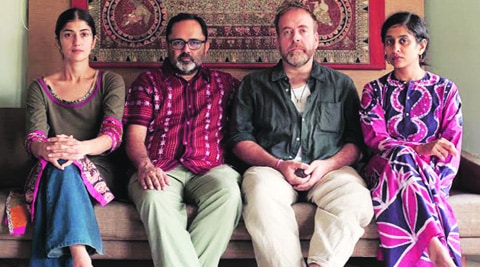
Blurring Boundaries: the question of ‘a’rt or ‘A’rt
Reviewed by Devki Modi
Shumona Goel, Michael Northam, Tabasheer Zutshi and Avjit Mukul Kishore presented one of the most authentic fusions of performance, cinema, musical sounds and art in their site-specific installation and experiential performance, The Way of Light.
Experimenta, an artist run platform that supports experimentation with film and sound in India, represents this collaboration. A Mumbai-based filmmaker, Goel has worked on site-specific installations that transform physical spaces into immersive sound and light environment, while cinematographer and filmmaker Mukul has worked on films such as ‘To let the world in’ and ‘Chronicles- the history of Contemporary Indian Art’. Zutshi, a production and costume designer from Goa has worked in films such as ‘Miss Lovely’ and ‘Tasheer Desh’ and US based Northam is a sound artist who draws his sounds from natural and found objects to create soundscapes.

(From left) Tabasheer Zutshi, Avijit Mukul Kishore, Michael Northam and Shumona Goel. Image Courtesy: Indian express.
Ernst Gombrich at the onset of his significant book ‘The Story of Art’ states, “There is no such thing as art. There are only artists. Art with a capital ‘A’ has come to be something of a bogey and a fetish”.
The shift in the artistic practice from the use of conventional disciplines like painting and sculpture to new media – photography, performance, installation, film and sound has opened up a plethora of new possibilities. While this is a new concept in India, experiments with sound in the gallery space have been taking place since early 20th century with ‘anti-art movements’ like Dadaism and Fluxus. The Dadaist and Fluxus group discarded the classical norms of painting, prejudices and set notions of looking and making art. It was a repulsive response to the socio-political and cultural values at that time in Europe and America. And closer to home, Indian artists such as Mithu Sen in her work ‘Garbled Verbiage’ and ‘I am a poet’ force the viewer to listen rather than see. Reena Saini Kallat’s ‘Untitled (map)’ uses recordings of found sound and experiments in her works.
The Way of Light is a product of the artists’ collective interest in the inter-relationship between sound, film, light, culture, space and the audience. It is a response to the restlessness of city life and the idea of returning to a tranquil nature in order to gain a transitory reprieve from the metropolitan. They question this idea and emphasize on yearning for a more natural way of living in the city. Aiming at creating a participatory viewer experience, the individual response of every participant facilitates to the improvisation of the performance.
Sound and light play central characters in this quasi-cinematic experience. They are reduced to their fundamental form. These intangible elements voyage the viewer through an internal hypno-meditative journey of awareness by way of self-consciousness and time suspension.
The venue, Theosophical Centre and Zoroastrian library, K.R.Cama Oriental Institute of Bombay makes an interesting conversation with the pseudo-ritualistic aspect of the performance. While it is free from the constraints of a gallery space, situating it around the Kala Ghoda art district of Mumbai keeps the dialogue ongoing as well as retaining the uplifting nature of the performance. Two sessions of 45 minutes each took place on 10th and 11th April 2014 at 7pm and 8:30pm.
Upon entering the space the viewer witnesses a complex seating arrangement of intersecting circles spread over Persian rugs and drapes hanging from the ceiling. The aroma of leaves, flowers and oils, dimmed green light and soft meditative music arranged extremely thoughtfully by the artists lead up to the performance. Whilst everyone was settling down, taking seats either on the chairs or pillows, the performance began unannounced.
The sound piece for this performance is built around frequency, F-tone that is amplified with soothing sounds played from a speaker at 528 hertz–the frequency of light during photosynthesis held in the artist’s hand that moves around with the speaker a few minutes into the performance. The sound rises and fades, interrupts and moves, while the light brightens and fades periodically throughout the performance. The artist controls the continuous alteration in the light and sound frequency. Thus they are as much a part of the ‘performance’ as the viewer.
The degree of involvement of each participant is individualistic and unique. While some preferred to lie down on the pillow through the course of the presentation, others remained seated on the chair till the end. A few viewers fell asleep whilst some were transported into various meditative states of awakening, observation, joy, contentment, concentration, mindfulness, insight and thoughtless-ness. A number of factors such as past occurrences and personal experiences influenced their reaction to the whole performance. Choosing to hang on to the residue of this transformative experience viewers preferred to leave the hall in silence at the end.
The artists succeeded in creating an in-between space literally and experientially by transporting the participant into another state of consciousness right in the middle of the city, in the comfort of their own space.
Retrospectively, the performance draws our attention to some of the crucial inquiries into present-day art practice. The nature of this artwork-performance questions the changing role of the white cube gallery space and makes us reconsider our current approach to art making. It brings to light the debate between ‘high art’ versus ‘low art’ and ‘visual culture’ versus ‘popular culture’. It urges us to look at art with a fresh and innovative point of view, at the same time it makes us re-experience an experience in all its originality sans the historical and critical baggage it is always clouded with.
